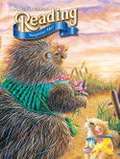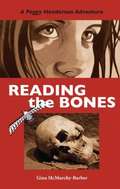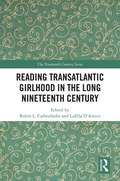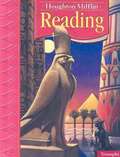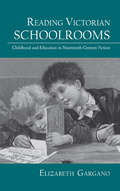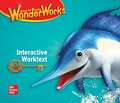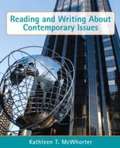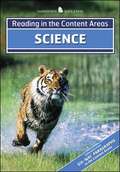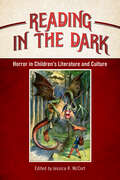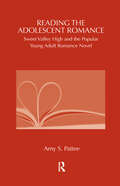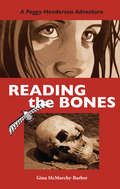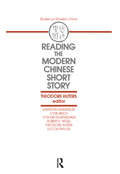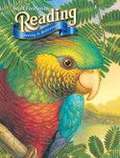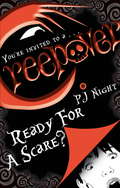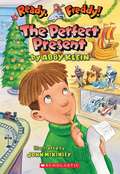- Table View
- List View
Reading Surprise Me! Level 1.6
by Scott ForesmanQuality literature, built-in skill instruction, and test preparation help every child become a successful reader who is prepared for state and national tests. The Grade 1 On-Level Readers provide six weeks of review for the skills previously covered in kindergarten.
Reading The Bones
by Gina Mcmurchy-BarberShort-listed for the 2009 Silver Birch Award, commended for the 2009 Best Books for Kids & Teens Due to circumstances beyond her control, 12-year-old Peggy Henderson has to move to the quiet town of Crescent Beach, British Columbia, to live with her aunt and uncle. Without a father and separated from her mother, who's looking for work, Peggy feels her unhappiness increasing until the day she and her uncle start digging a pond in the backyard and she realizes the rock she's been trying to pry from the ground is really a human skull. Peggy eventually learns that her home and the entire seaside town were built on top of a 5000-year-old Coast Salish fishing village. With the help of an elderly archaeologist, a woman named Eddy, Peggy comes to know the ancient storyteller buried in her yard in a way that few others can - by reading the bones. As life with her aunt becomes more and more unbearable, Peggy looks to the old Salish man from the past for help and answers.
Reading Time (Fountas & Pinnell Classroom, Guided Reading)
by Paul VassosNIMAC-sourced textbook. A Place to Read. Everyone in this book finds a special place to read. Where do you like to sit and read?
Reading Transatlantic Girlhood in the Long Nineteenth Century (The Nineteenth Century Series)
by Robin L. Cadwallader LuElla D’AmicoThis collection is the first of its kind to interrogate both literal and metaphorical transatlantic exchanges of culture and ideas in nineteenth-century girls’ fiction. As such, it initiates conversations about how the motif of travel in literature taught nineteenth-century girl audiences to reexamine their own cultural biases by offering a fresh perspective on literature that is often studied primarily within a national context. Women and children in nineteenth-century America are often described as being tied to the home and the domestic sphere, but this collection challenges this categorization and shows that girls in particular were often expected to go abroad and to learn new cultural frames in order to enter the realm of adulthood; those who could not afford to go abroad literally could do so through the stories that traveled to them from other lands or the stories they read of others’ travels. Via transatlantic exchange, then, authors, readers, and the characters in the texts covered in this collection confront the idea of what constitutes the self. Books examined in this volume include Adelaide Trafton’s An American Girl Abroad (1872), Johanna Spyri’s Heidi (1881), and Elizabeth W. Champney’s eleven-book Vassar Girl Series (1883-92), among others.
Reading Triumphs
by J. David Cooper John J. Pikulski Houghton Mifflin Company StaffThis comprehensive intervention program supports those students reading two grade-levels below with intensive instruction focused on priority skills to accelerate instruction.
Reading Victorian Schoolrooms: Childhood and Education in Nineteenth-Century Fiction (Children's Literature and Culture #44)
by Elizabeth GarganoReading Victorian Schoolrooms examines the numerous schoolroom scenes in nineteenth-century novels during the fraught era of the Victorian education debates. As Gargano argues, the fiction of mainstream and children’s writers such as Dickens, Brontë, and Carroll reflected widespread Victorian anxieties about the rapid institutionalization of education and the shrinking realm of domestic instruction. As schools increasingly mapped out a schema of time schedules, standardized grades or forms, separate disciplines, and hierarchical architectural spaces, childhood development also came to be seen as regularized and standardized according to clear developmental categories. Yet, Dickens, Brontë, and others did not simply critique or satirize the standardization of school experience. Instead, most portrayed the schoolroom as an unstable site, incorporating both institutional and domestic space. Drawing on the bildungsroman’s traditional celebration of an individualized, experiential education, numerous novels of school life strove to present the novel itself as a form of domestic education, in contrast to the rigors of institutional instruction. By positioning the novel as a form of domestic education currently under attack, these novelists sought to affirm its value as a form of protest within an increasingly institutionalized society. The figure of the child as an emblem of beleaguered innocence thus became central to the Victorian fictive project.
Reading Wonderworks Interactive Worktext Grade 2 (Reading Intervention)
by Douglas Fisher Timothy Shanahan Jan HasbrouckThe Interactive Worktext for grades 2-6 is a scaffolded version of the Reading Wonders Reading/Writing Workshop. It allows students to interact with complex texts through close reading by taking notes, marking text evidence, and writing responses in their own print or eBook version.
Reading Wonderworks: Interactive Worktext Grade 4 (Reading Intervention Ser.)
by Douglas Fisher Timothy Shanahan Jan HasbrouckReseña del editor: The Interactive Worktext for grades 2-6 is a scaffolded version of the Reading Wonders Reading/Writing Workshop. It allows students to interact with complex texts through close reading by taking notes, marking text evidence, and writing responses in their own print or eBook version.
Reading and Writing About Contemporary Issues
by Kathleen T. McwhorterReading and Writing About Contemporary Issues offers an integrated approach to reading and writing using a handbook for reference and instruction followed by readings for analysis and writing.
Reading for Christian Schools 5
by Bju StaffA book that helps students build their reading and thinking skills by use of literature materials provided.
Reading in the Content Areas: Science
by McGraw-Hill Jamestown Education StaffBased on the best-selling Six-Way Paragraphs books, these individual titles help students master the essential skills needed to organize, understand, and apply information in math, science, and social studies. Here are the books that will open doors for you into your content area classrooms.
Reading in the Dark: Horror in Children's Literature and Culture (Children's Literature Association Series)
by Jessica R. McCortContributions by Rebecca A. Brown, Justine Gieni, Holly Harper, Emily L. Hiltz, A. Robin Hoffman, Kirsten Kowalewski, Peter C. Kunze, Jorie Lagerwey, Nick Levey, Jessica R. McCort, and Janani SubramanianDark novels, shows, and films targeted toward children and young adults are proliferating wildly. It is even more crucial now to understand the methods by which such texts have traditionally operated and how those methods have been challenged, abandoned, and appropriated. Reading in the Dark fills a gap in criticism devoted to children's popular culture by concentrating on horror, an often-neglected genre. These scholars explore the intersection between horror, popular culture, and children's cultural productions, including picture books, fairy tales, young adult literature, television, and monster movies.Reading in the Dark looks at horror texts for children with deserved respect, weighing the multitude of benefits they can provide for young readers and viewers. Refusing to write off the horror genre as campy, trite, or deforming, these essays instead recognize many of the texts and films categorized as "scary" as among those most widely consumed by children and young adults. In addition, scholars consider how adult horror has been domesticated by children's literature and culture, with authors and screenwriters turning that which was once horrifying into safe, funny, and delightful books and films. Scholars likewise examine the impetus behind such re-envisioning of the adult horror novel or film as something appropriate for the young. The collection investigates both the constructive and the troublesome aspects of scary books, movies, and television shows targeted toward children and young adults. It considers the complex mechanisms by which these texts communicate overt messages and hidden agendas, and it treats as well the readers' experiences of such mechanisms.
Reading the Adolescent Romance: Sweet Valley High and the Popular Young Adult Romance Novel (Children's Literature and Culture)
by Amy PatteeReading the Adolescent Romance provides an exhaustive study of the developments in young adult literature since the 1980s with a focus on Francine Pascal’s "Sweet Valley High" series, which has become a cultural and literary touchstone for both fans and critics of the novels. Pattee carefully examines the series’ content, structure, and readers, allowing her to investigate an influential marketing and literary phenomenon and to interrogate the intersecting influences of history, audience positioning, and readability that allowed "Sweet Valley" and other teen series to flourish. This book demonstrates that, as a series of generic romance novels, "Sweet Valley High" exhibits tropes associated with both adolescent and adult romance and, as a product of the early 1980s, has and continues to espouse the conservative romantic ideologies associated with the time period. While erstwhile readers of the series recall the novels with pleasure, re-readers of Pascal’s novels — who remember reading the series as young people and have re-visted the books as adults — are more critical. Interestingly, both populations continue to value "Sweet Valley High" as an identity touchstone. Amy Pattee is an associate professor of library and information science at the Graduate School of Library and Information Science at Simmons College in Boston, Massachusetts. There, she teaches children’s and young adult literature in both the library school and in a dual degree program affiliated with Simmons College’s Center for the Study of Children’s Literature.
Reading the Bones: A Peggy Henderson Adventure
by Gina Mcmurchy-BarberShort-listed for the 2009 Silver Birch Award, commended for the 2009 Best Books for Kids & Teens Due to circumstances beyond her control, 12-year-old Peggy Henderson has to move to the quiet town of Crescent Beach, British Columbia, to live with her aunt and uncle. Without a father and separated from her mother, who’s looking for work, Peggy feels her unhappiness increasing until the day she and her uncle start digging a pond in the backyard and she realizes the rock she’s been trying to pry from the ground is really a human skull. Peggy eventually learns that her home and the entire seaside town were built on top of a 5000-year-old Coast Salish fishing village. With the help of an elderly archaeologist, a woman named Eddy, Peggy comes to know the ancient storyteller buried in her yard in a way that few others can – by reading the bones. As life with her aunt becomes more and more unbearable, Peggy looks to the old Salish man from the past for help and answers.
Reading the Modern Chinese Short Story (Studies On Modern China)
by Theodore HutersTranslations of six stories accompany seven papers from a workshop on critical approaches to modern Chinese short stories held at the U. of Hawaii in December 1982. With one exception, the essays analyze the stories presented, looking at such factors as the psychological structure, the narrator, ide
Reading the Sun / Reading the Wind (Fountas & Pinnell Classroom, Guided Reading)
by Jacqueline AdamsNIMAC-sourced textbook
Reading: Seeing Is Believing
by Scott ForesmanQuality literature, built-in skill instruction, and test preparation help every child become a successful reader who is prepared for state and national tests. The Grade 1 On-Level Readers provide six weeks of review for the skills previously covered in kindergarten.
Ready Common Core: Mathematics Practice 3 (PARCC Edition)
by The Editors at the Curriculum AssociatesThis is a review program for the Common Core State Standards in Mathematics. This book has three practice tests. In each practice test, you will answer 40 to 49 questions in the key areas of Mathematics.
Ready For A Scare?: Book 3 (Creepover #3)
by P. J. NightBirthday girl and queen of all things spooky, Kelly Garcia is all set to have the perfect night. First her parents are stuck out of town. Sure there's a babysitter, but Kelly is excited to basically be on her own.And then there's her sleepover - a webcam sleepover where she and her friends can scare one another by summoning the spirit of Miss Mary, a woman from their small town who died tragically a long time ago.But when her friends start disappearing one by one and the babysitter is nowhere to be found, Kelly starts getting scared . . . for real. Is Miss Mary's ghost kidnapping everyone? Will Kelly be next?
Ready Freddy! The Perfect Present: ` (Ready Freddy! #18)
by Abby KleinFreddy is sure Santa will bring him everything he's wishing for. But when Freddy learns not every kid is as lucky as he is, he starts to wonder. Could giving presents be as much fun as getting them?
Ready New York CCLS 2014 English Language Arts Instruction Grade 4
by Curriculum AssociatesThis book uses best-practice teaching strategies and routines to help students in early grades develop reading comprehension skills assessed by the Common Core.
Ready New York CCLS English Language Arts Instruction, Grade 5
by Curriculum AssociationsReady New York CCLS English Language Arts Instruction, Grade 5
Ready New York CCLS Instruction: Mathematics (Grade #4)
by Curriculum AssociatesMath book aligned to Common Core Standards.
